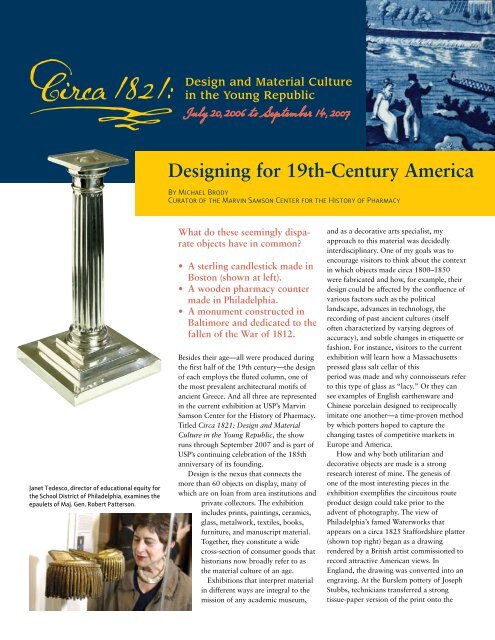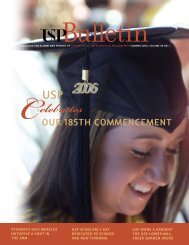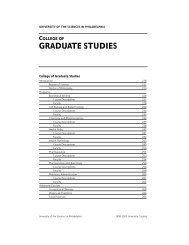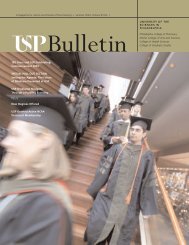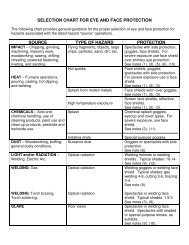Design<strong>in</strong>g for 19th-Century AmericaBy Michael BrodyCurator <strong>of</strong> <strong>the</strong> Marv<strong>in</strong> Samson Center for <strong>the</strong> History <strong>of</strong> PharmacyJanet Tedesco, director <strong>of</strong> educational equity for<strong>the</strong> School District <strong>of</strong> Philadelphia, exam<strong>in</strong>es <strong>the</strong>epaulets <strong>of</strong> Maj. Gen. Robert Patterson.What do <strong>the</strong>se seem<strong>in</strong>gly disparateobjects have <strong>in</strong> common?• A sterl<strong>in</strong>g candlestick made <strong>in</strong>Boston (shown at left).• A wooden pharmacy countermade <strong>in</strong> Philadelphia.• A monument constructed <strong>in</strong>Baltimore and dedicated to <strong>the</strong>fallen <strong>of</strong> <strong>the</strong> War <strong>of</strong> 1812.Besides <strong>the</strong>ir age—all were produced dur<strong>in</strong>g<strong>the</strong> first half <strong>of</strong> <strong>the</strong> 19th century—<strong>the</strong> design<strong>of</strong> each employs <strong>the</strong> fluted column, one <strong>of</strong><strong>the</strong> most prevalent architectural motifs <strong>of</strong>ancient Greece. And all three are represented<strong>in</strong> <strong>the</strong> current exhibition at <strong>USP</strong>’s Marv<strong>in</strong>Samson Center for <strong>the</strong> History <strong>of</strong> Pharmacy.Titled Circa 1821: Design and MaterialCulture <strong>in</strong> <strong>the</strong> Young Republic, <strong>the</strong> showruns through September 2007 and is part <strong>of</strong><strong>USP</strong>’s cont<strong>in</strong>u<strong>in</strong>g celebration <strong>of</strong> <strong>the</strong> 185thanniversary <strong>of</strong> its found<strong>in</strong>g.Design is <strong>the</strong> nexus that connects <strong>the</strong>more than 60 objects on display, many <strong>of</strong>which are on loan from area <strong>in</strong>stitutions andprivate collectors. <strong>The</strong> exhibition<strong>in</strong>cludes pr<strong>in</strong>ts, pa<strong>in</strong>t<strong>in</strong>gs, ceramics,glass, metalwork, textiles, books,furniture, and manuscript material.Toge<strong>the</strong>r, <strong>the</strong>y constitute a widecross-section <strong>of</strong> consumer goods thathistorians now broadly refer to as<strong>the</strong> material culture <strong>of</strong> an age.Exhibitions that <strong>in</strong>terpret material<strong>in</strong> different ways are <strong>in</strong>tegral to <strong>the</strong>mission <strong>of</strong> any academic museum,and as a decorative arts specialist, myapproach to this material was decidedly<strong>in</strong>terdiscipl<strong>in</strong>ary. One <strong>of</strong> my goals was toencourage visitors to th<strong>in</strong>k about <strong>the</strong> context<strong>in</strong> which objects made circa 1800–1850were fabricated and how, for example, <strong>the</strong>irdesign could be affected by <strong>the</strong> confluence <strong>of</strong>various factors such as <strong>the</strong> politicallandscape, advances <strong>in</strong> technology, <strong>the</strong>record<strong>in</strong>g <strong>of</strong> past ancient cultures (itself<strong>of</strong>ten characterized by vary<strong>in</strong>g degrees <strong>of</strong>accuracy), and subtle changes <strong>in</strong> etiquette orfashion. For <strong>in</strong>stance, visitors to <strong>the</strong> currentexhibition will learn how a Massachusettspressed glass salt cellar <strong>of</strong> thisperiod was made and why connoisseurs referto this type <strong>of</strong> glass as “lacy.” Or <strong>the</strong>y cansee examples <strong>of</strong> English ear<strong>the</strong>nware andCh<strong>in</strong>ese porcela<strong>in</strong> designed to reciprocallyimitate one ano<strong>the</strong>r—a time-proven methodby which potters hoped to capture <strong>the</strong>chang<strong>in</strong>g tastes <strong>of</strong> competitive markets <strong>in</strong>Europe and America.How and why both utilitarian anddecorative objects are made is a strongresearch <strong>in</strong>terest <strong>of</strong> m<strong>in</strong>e. <strong>The</strong> genesis <strong>of</strong>one <strong>of</strong> <strong>the</strong> most <strong>in</strong>terest<strong>in</strong>g pieces <strong>in</strong> <strong>the</strong>exhibition exemplifies <strong>the</strong> circuitous routeproduct design could take prior to <strong>the</strong>advent <strong>of</strong> photography. <strong>The</strong> view <strong>of</strong>Philadelphia’s famed Waterworks thatappears on a circa 1825 Staffordshire platter(shown top right) began as a draw<strong>in</strong>grendered by a British artist commissioned torecord attractive American views. InEngland, <strong>the</strong> draw<strong>in</strong>g was converted <strong>in</strong>to anengrav<strong>in</strong>g. At <strong>the</strong> Burslem pottery <strong>of</strong> JosephStubbs, technicians transferred a strongtissue-paper version <strong>of</strong> <strong>the</strong> pr<strong>in</strong>t onto <strong>the</strong>
usp bullet<strong>in</strong>: design<strong>in</strong>g for 19th-century america page 11MARVIN SAMSON, vice chairman <strong>of</strong><strong>the</strong> <strong>USP</strong> board <strong>of</strong> trustees, studies <strong>the</strong>Staffordshire platter that bears animage <strong>of</strong> Philadelphia’s Waterworks(shown at far left) at <strong>the</strong> Circa 1821exhibition open<strong>in</strong>g <strong>in</strong> November 2006.ceramic matrix, and after <strong>in</strong>k<strong>in</strong>g and fir<strong>in</strong>g,hundreds <strong>of</strong> <strong>the</strong>se large platters—and o<strong>the</strong>rtableware onto which this scene, or parts<strong>of</strong> it, was similarly reproduced—were soldacross Europe or exported to America.Consequently, well-to-do Philadelphianswere able to enjoy an ear<strong>the</strong>nware“snapshot” <strong>of</strong> one <strong>of</strong> <strong>the</strong> most importantand attractive Greek revival build<strong>in</strong>gs <strong>of</strong><strong>the</strong>ir city.One <strong>of</strong> <strong>the</strong> reward<strong>in</strong>g (and frustrat<strong>in</strong>g)aspects <strong>of</strong> curat<strong>in</strong>g an exhibition is <strong>the</strong>acquisition <strong>of</strong> vital object <strong>in</strong>formation afterwall labels have been written and <strong>the</strong> showis opened to <strong>the</strong> public. Case <strong>in</strong> po<strong>in</strong>t: <strong>in</strong>late October 2006, while sift<strong>in</strong>g throughearly 20th-century auction catalogues for anentirely different project, I came across anillustration <strong>of</strong> four French pharmacy jarsfrom <strong>the</strong> same series to which one <strong>of</strong> <strong>the</strong>porcela<strong>in</strong> jars <strong>in</strong> <strong>the</strong> exhibition (shown atright) clearly belongs.“One <strong>of</strong> <strong>the</strong> reward<strong>in</strong>g (and frustrat<strong>in</strong>g) aspects<strong>of</strong> curat<strong>in</strong>g an exhibition is <strong>the</strong> acquisition <strong>of</strong> vitalobject <strong>in</strong>formation after wall labels have beenwritten and <strong>the</strong> show is opened to <strong>the</strong> public.”Michael Brody, Curator<strong>The</strong> catalogue was for <strong>the</strong> 1935 sale <strong>of</strong><strong>the</strong> eclectic New York art collection belong<strong>in</strong>gto several members <strong>of</strong> <strong>the</strong> Wanamakerfamily, <strong>in</strong>clud<strong>in</strong>g John Wanamaker, Jr., son<strong>of</strong> <strong>the</strong> founder <strong>of</strong> <strong>the</strong> famous eponymousPhiladelphia department store that closedabout a decade ago. One <strong>of</strong> <strong>the</strong> highlights <strong>of</strong><strong>the</strong> sale was a “seventeenth-century paneledwalnut pharmacy room with remarkablecollection <strong>of</strong> pharmacy jars,” that had beencollected by Rodman Wanamaker. Indeed,<strong>the</strong> collection consisted <strong>of</strong> dozens <strong>of</strong>porcela<strong>in</strong> and ear<strong>the</strong>nware vessels from <strong>the</strong>17th through 19th centuries, made <strong>in</strong> Italy,France, Spa<strong>in</strong>, Portugal, England, and <strong>the</strong>Ne<strong>the</strong>rlands. <strong>The</strong> preface to a subset <strong>of</strong><strong>the</strong>se jars, lots 446 to 455, states:<strong>The</strong> follow<strong>in</strong>g lots form an importantset <strong>of</strong> Paris porcela<strong>in</strong> pharmacy jars <strong>of</strong><strong>the</strong> Empire period by Deroche Frèresand o<strong>the</strong>rs, and come from a pharmacy<strong>in</strong> Blois, to which <strong>the</strong>y were presented <strong>in</strong>1810 by <strong>the</strong> pr<strong>in</strong>ces <strong>of</strong> Spa<strong>in</strong> heldprisoner <strong>in</strong> Valençay by Napoleon I.(American Art Association, AndersonGalleries, Inc., New York; sale dates13–16 March 1936, p. 70)<strong>The</strong> 10 lotsdescribe 45 separateobjects <strong>of</strong> two sizes:29 at 10” high(<strong>in</strong>clud<strong>in</strong>g lids), <strong>in</strong>various conditionstates; and 15 at 61/2” high (<strong>in</strong>clud<strong>in</strong>glids miss<strong>in</strong>g <strong>the</strong>irf<strong>in</strong>ials). <strong>The</strong> <strong>USP</strong> jar lacks a lid, though itssize (about 7 3/4” high), means it belongedto <strong>the</strong> first height group, and was almostcerta<strong>in</strong>ly one <strong>of</strong> <strong>the</strong> five jars described <strong>in</strong> lot452 as “lack<strong>in</strong>g covers.”On stylistic basis, I dated <strong>the</strong> <strong>USP</strong> jarto circa 1820–1840. <strong>The</strong> provenance<strong>in</strong>formation given <strong>in</strong><strong>the</strong> 1935 auctioncatalogue, which Ihave no reason tosuspect is spurious,suggests <strong>the</strong> entireseries <strong>of</strong> storage jarswas made <strong>in</strong> 1810,or slightly earlier.Interest <strong>in</strong> Egyptiandesign was generatedby <strong>the</strong> discoveriesand records <strong>of</strong>Napoleon’s expeditionto Egypt <strong>in</strong> 1798, and as I proposed <strong>in</strong> myexhibition label, <strong>the</strong> wonderful sph<strong>in</strong>xes at<strong>the</strong> base <strong>of</strong> <strong>the</strong> jar were almost certa<strong>in</strong>lyderived from Percier and Fonta<strong>in</strong>e’ssubsequent Recueil de DécorationsIntérieures, published <strong>in</strong> Paris <strong>in</strong> 1801 and1812. (This tome also happens to be <strong>the</strong> firstpr<strong>in</strong>ted guide or pattern book <strong>of</strong> Greek,Roman, and Egyptian designs based onarcheological sources.)Due to this m<strong>in</strong>or but <strong>in</strong>terest<strong>in</strong>g auctioncatalogue “discovery,” <strong>the</strong> <strong>USP</strong> jar can nowbe attributed, at least provisionally, to <strong>the</strong>Paris factory <strong>of</strong> Deroche Frères—likely part<strong>of</strong> a large commission by <strong>the</strong> pr<strong>in</strong>ces <strong>of</strong>Spa<strong>in</strong> for <strong>the</strong> apo<strong>the</strong>cary <strong>in</strong> <strong>the</strong> royalchateau at Blois. I hope readers will agreethis is notable and excit<strong>in</strong>g new <strong>in</strong>formationfor <strong>the</strong> museum’s collection records.For more <strong>in</strong>formation about <strong>the</strong>exhibition, <strong>in</strong>clud<strong>in</strong>g hours, visitwww.usip.edu/museum, <strong>the</strong>n clickon <strong>the</strong> “exhibitions” l<strong>in</strong>k.


